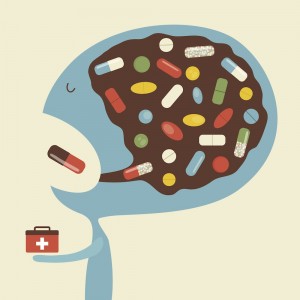
Today we feature another guest blog from Professor Simon Hatcher’s excellent blog. We’ll be posting one blog every month from Simon who is Full Professor of Psychiatry at The University of Ottawa – Editor.
Well it’s not actually a journal article but as everyone and their dog has an opinion on the launch of DSM-5 (the Fifth Edition of the Diagnostic and Statistical Manual of Mental Disorders) I thought I would pitch in as well.
Why bother with classification at all?
We have classification because it is useful for communication and ultimately inevitable. The reason that it is inevitable is that once you recognize that some people share something in common that other people do not have – low mood or forgetfulness for example – you are creating a classificatory system. The other choices are everyone is unique (not that useful because it means you can’t apply lessons from one person to another) or that everyone is the same (again not that useful).
So given that we have to have a system of classification in medicine what should it look like? There are three choices:
- Classification by symptoms
- By course of the disorder
- By aetiology (the cause of the disorder)
Historical perspective

On the whole, mental health patients and professionals are stuck with a symptomatic classification of disorders
Until the mid-19th century most disorders in medicine were classified by symptoms – so a reading of medical textbooks from the 1700s would have several chapters on different types of fever. This changed as more knowledge was gained about how the body worked and links were made between pathology and symptoms in life. For most medical disciplines the classification changed from symptoms to aetiology so that physicians today don’t diagnose central crushing chest pain disorder (a symptom), they diagnosis a myocardial infarction (an aetiology). Classification by course of a disorder has been tried in medicine but is never really that successful as it can only be done retrospectively.
The reason that classification never shifted from symptoms to aetiologies in psychiatry is that the brain is the most complex organ in the human body (whose workings we still don’t fully understand), which is enclosed in a bony box (the skull), making it hard to study (unlike the heart or pancreas for example). So in psychiatry, with a few exceptions, we are still stuck with a symptomatic classification of disorders. The trouble with symptomatic classifications is that they are not really that powerful in helping decisions about treatment or prognosis – hence the focus on formulations in training psychiatrists which attempt to take a wider view of the aetiology and impact of disorders.
The criticisms of DSM-5
Which brings us to DSM-5. This is a classification by symptoms from a particularly U.S. point of view. The two big criticisms of DSM-5 are that it medicalizes what should be normal and that, while it pretends to be biomedical, the evidence for the biological basis for most disorders is lacking.
In my opinion there is considerable merit in the argument about DSM-5 being an attempt to medicalize the normal – a sort of “psychiatric mission creep”. The suspicion here is of the influence of pharmaceutical companies on the designers of DSM-5 to create new markets.
There are many examples of undeclared conflicts of interest, particularly in U.S. academic psychiatry, influencing the research agenda and the interpretation of research. The other financial conflict concerns the American Psychiatric Association who publishes the DSM. The drafting of DSM-5 has missed most deadlines except the final publication and launch date, leading to the suspicion that the APA is in poor financial straits and needs the DSM to come out now in order to collects the money it makes from its sales.
The second argument about the DSM-5 is that it does not reflect biological reality and the comparison is often made with the rest of medicine. However, many disorders in medicine are equally subjective (pain for example) or their cause is obscure (headaches or migraines anyone?). Also disorders in other areas of medicine regularly undergo reclassification (epilepsy or acute coronary events come to mind).
Integrating biology, psychology and sociology

Good mental health practice means integrating biology, psychology and sociology in a complete package
Critics often condemn the “medical model” when what they really are referring to is a reductionist biological model that equates all disease with biological pathology. However, anyone who spends any time on a medical ward round or out-patient clinic will quickly discover that the “medical model” actually means integrating biology, psychology and sociology in a complete package.
So in psychiatry we are still left with a predominantly symptomatic classification to understand people who present with distress. Our focus should be on improving and defending services for such people and, as good clinicians, integrating psychology and biology to do something helpful.
The role of classificatory symptoms is often exaggerated – the best quote I have heard about them is that:
they are like lines of longitude and latitude – nothing like them exists in the real world – but they are helpful in finding your way around.
Link
Diagnostic and Statistical Manual of Mental Disorders fifth edition (DSM-5). American Psychiatric Association, May 2013.



The DSM-5 and the complexities and capitalising of classification: Today we feature another guest blog from Pr… http://t.co/7t5jGnhLAu
Interesting guest blog on @Mental_Elf about DSM-5 and the challenges of classification http://t.co/v09BImS7Zu
@deevybee Interested in your thoughts on: “The DSM-5 and the complexities and capitalising of classification” http://t.co/gBB9UaEkAY
@Mental_Elf Interesting topic, but alas, have been overdoing emergency blogging and must now do some catch-up with the day-job.
Pls RT @Rethink_ Everything you always wanted to know about DSM-5, but were afraid to ask: http://t.co/gBB9UaEkAY
@Mental_Elf @hermitsholiday @Rethink_ Fell asleep during second paragraph.
Pls RT @MindCharity Everything you always wanted to know about DSM-5, but were afraid to ask: http://t.co/gBB9UaEkAY
RT @mental_elf: Everything you always wanted to know about DSM-5, but were afraid to ask: http://t.co/C9vejdSPDA
RT @LifestyleElf: RT @mental_elf: Everything you always wanted to know about DSM-5, but were afraid to ask: http://t.co/wzhcLrYqmp #dsm5
@shatchernz on DSM-5 & why clinicians seek to integrate biology, psychology & sociology in their practice http://t.co/gBB9UaEkAY
Recommended reading from Prof Simon Hatcher: Everything you ever wanted to know about DSM-5, but were afraid to ask.
Mental health patients & professionals are stuck with a symptomatic classification of disorders http://t.co/gBB9UaEkAY #DSM5
Mental health professionals! Tell us what you think of this blog on #DSM5 from @shatchernz http://t.co/gBB9UaEkAY
@Mental_Elf @shatchernz I don’t think I can pay any attention to DSM V.
Is Big Pharma medicalising normal human behaviour, to sell more drugs and maximise their profits? http://t.co/gBB9UaEkAY #DSM5
@Mental_Elf Seems 2 me 2 b such a redundant & tired question. YES! Their responsibility is 2 make as much $ 4 their shareholders as possible
@Mental_Elf it may be a seemingly redundant question but they still have big influence over this diagnostic system
The DSM-5 and the complexities and capitalising of classification – The Mental Elf http://t.co/AaOXBGnFT2 #paperli
At last, a balanced piece on DSM-5, from Professor of Psychiatry @shatchernz http://t.co/gBB9UaEkAY
DSM-5: the history, strengths and weaknesses of mental health classification http://t.co/gBB9UaEkAY
@Mental_Elf hi u know my story right?
@Mental_Elf I have an exam this week and classification is something I am revising – thank you!!
In case you missed it: The DSM-5 and the complexities and capitalising of classification http://t.co/gBB9UaEkAY
An interesting blog on the DSM-5. Is the influence of pharmaceutical companies medicalising the normal? http://t.co/nMJXc56Qct